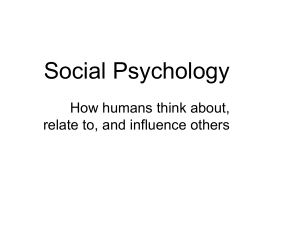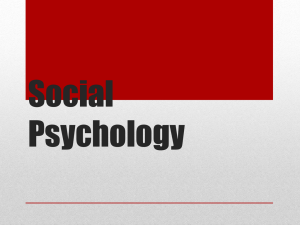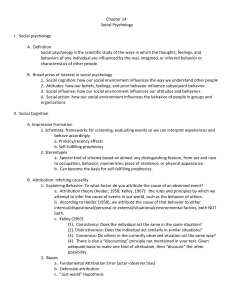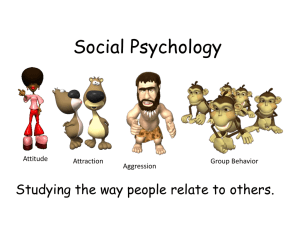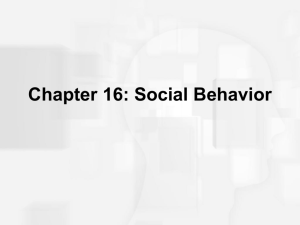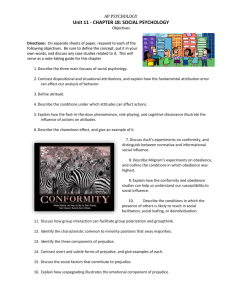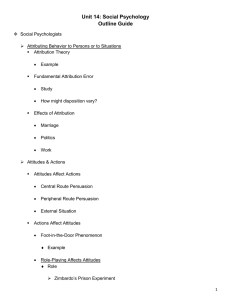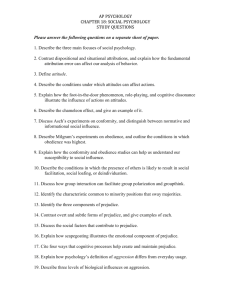Social Psychology
advertisement
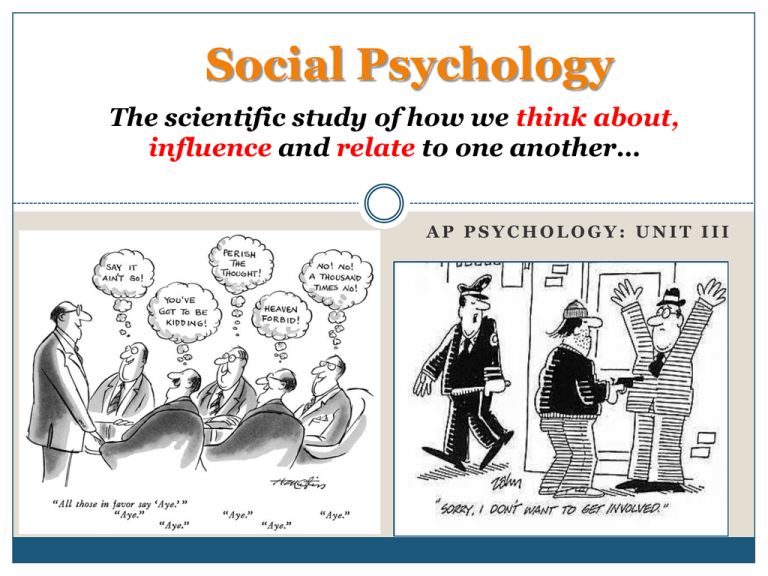
Social Psychology The scientific study of how we think about, influence and relate to one another… AP PSYCHOLOGY: UNIT III Introduction: Fact or Falsehood? Most people refuse to obey an authority figure who has told them to hurt an innocent person False In order to change people’s racist behaviors, we first need to change their racist attitudes False We are less likely to offer help to a stranger if other bystanders are present True Introduction: Fact or Falsehood? Individuals pull harder in a team tug-of-war than when they pull in a one-on-one tug-of-war False The higher the morale & harmony of a social group, the more likely its members are to make a good decision False From research on liking & loving, it is clear that opposites do attract False Studies of college & professional athletic events indicate that home teams win about 60% of the time True Social Psychology: Social Thinking, Attribution Explaining Behavior Social Thinking: Attribution Attribution Theory (Fritz Heider) The theory that suggests the way in which we explain the behavior of others… We attribute behavior to internal dispositions or external situations Example • Was my friend a jerk because he had a bad day or is he simply a bad person? Social Thinking: Attribution Social Thinking: Attribution 3 Factors: Internal vs. External causes Dispositional Distinctive Is factors vs. Situational factors or Consistent behavior this an isolated incident or does it occur often? Consensus Are other people acting the same way? Social Thinking: Attribution Fundamental Attribution Error The tendency for observers, when analyzing another’s behavior, to overestimate the impact of personal disposition and underestimate the impact of the situation Example How do students typically view a teacher’s cranky behavior? • Most probably attribute it to their personality, as opposed to their profession… Social Thinking: Attribution You believe that cheating is bad/wrong... But you cheat on your math test… Your teacher was mean; in that class it was okay… Social Thinking: Attribution What is the function of the fundamental attribution error? To protect our self-esteem If we do something wrong, it makes us feel better to blame outside factors, as opposed to blaming ourselves Social Thinking: Attribution Defensive Attribution Tendency to blame victims for their misfortune One feels less likely to be victimized in a similar way Also know as “Just-World Bias” “What terrible criminals these prisoners must have been to receive such treatment…” Social Psychology: Social Thinking, Attitudes Making Social Judgments Social Thinking: Attitudes Attitudes Feelings, based on our beliefs, that predispose our reactions to objects, people, and events Social Thinking: Attitudes Components of Attitude Attitudes may include up to 3 different components Affective Component Feelings stimulated by an object of thought Cognitive Component Beliefs about the object of an attitude Behavioral Component Predispositions to act in certain ways toward an attitude object Social Thinking: Attitudes Dimensions of Attitude Attitudes may vary along several crucial dimensions Strength How firmly held? Durable over time? Impact on behavior? Accessibility How often & how quickly does it come to mind? Ambivalence (mixed feelings) Conflicted evaluations that include both positive and negative feelings The higher the level of ambivalence the less predictive of behavior Social Thinking: Attitudes Methods of Attitude Persuasion Central Route Persuasion Occurs when interested/analytical people focus on the arguments & respond with favorable thoughts Example: Followers of world religions Peripheral Route Persuasion Occurs when people are influenced by incidental cues, such as a speaker’s attractiveness or endorsements by respected people Example: Kennedy v. Nixon (1960) Social Thinking: Attitudes #1) Source (WHO) • • • • • • Credibility Expertise Trustworthiness Likability Attractiveness Similarity #2) Message (WHAT) • Fear appeal v. logic • One-sided v. two-sided argument • Number of strong or weak arguments • Repetition #3) Channel (DELIVERY) • • • • • In person On TV or radio Via audiotape Via internet Via telephone #4) Receiver (TO WHOM) • • • • Personality Expectations Initial attitude on issue Strength of preexisting attitude Factors in Attitude Persuasion Social Thinking: Attitudes Cognitive Dissonance Theory The theory that we act to reduce the dissonance (discomfort) we feel when two of our thoughts are inconsistent Attitudes vs. Actions Example A person who smokes, yet knows the health risks will either… • Stop smoking, or • Rationalize that nothing bad will happen to them Cognitive Dissonance Example The cheesecake calls out to Coach King causing feelings of guilt Social Psychology: Social Influence, Conformity Adjusting one’s behavior or thinking to coincide with a group standard; yielding to real or imagined social pressure Normative Behavior WHAT ARE SOME OF THE SOCIALLY ACCEPTED NORMS THAT EXIST WITHIN OUR SOCIETY? CONSIDER VARIOUS SETTINGS: PUBLIC SETTINGS, BATHROOM, ELEVATOR, CLASSROOM, DINING, PHONE CONVERSATIONS Social Influence: Conformity Influential Studies Asch’s Conformity Study (Solomon Asch, 1955) 50 subjects; young, undergraduate men Found that participants conformed on 37% of all trials • 75% conformed at least once • Of the 50 participants… 13 never caved 14 conformed on more than half of the trials Social Influence: Conformity Conditions that Strengthen Conformity Feelings of incompetence or insecurity Group size; at least 3 people Group is unanimous Admiration of the group’s status/attractiveness No prior commitment to any other response Strong cultural “respect” for social standards Social Influence: Conformity Reasons for Conforming Normative Social Influence Conformity to social norms for fear of negative social consequences Informational Social Influence Conformity to social norms when one looks to others for guidance about how to behave in ambiguous situations Normative Social Influence or Informational Social Influence? Social Psychology: Social Influence, Compliance A change in behavior prompted by a direct request, as opposed to social norm pressure Social Influence: Compliance Foot-in-the-Door Phenomenon The tendency for people who have first agreed to a small request to comply later with a large request Considerations The original small agreement creates a bond between the requestor and the requestee Pro-social technique requests are especially effective with this Social Influence: Compliance Door-in-the-Face Phenomenon The tendency for people who have first disagreed to a large request, to accept a more reasonable request Considerations The individual feels guilty for turning down the first request; fears rejection if they continue to decline The second request looks good compared to the first Social Influence: Compliance Low-Ball Technique The tendency for people to accept an unattractive detail if it is introduced after the deal is made, but not the other way around Considerations People will behave consistently to their beliefs in order to sustain their commitment Many may believe that they can’t back out after the initial agreement Social Influence: Compliance Ingratiation Involves getting someone to like you in order to obtain compliance with a request Considerations Flattery: Focus on positive elements in order to let the “target” know that you think highly of them Opinion Conformity: Agree with the beliefs & values of the “target;” allow them to “convince” you of their opinion Self-Presentation: Present yourself in a manner that the “target” would like Social Psychology: Social Influence, Obedience A form of compliance that occurs when people follow direct commands, usually from someone in a position of authority Social Influence: Obedience Influential Studies The Milgram Experiment (Stanley Milgram, 1974) “I was only following orders…” Adolf Eichmann Administration of electrical shocks (varying levels) Findings? “The most fundamental lesson of our study is that ordinary people, simply doing their jobs, and without any particular hostility on their part, can become agents in a terrible destructive process…” – Stanley Milgram Milgram’s Experiment How can cognitive dissonance theory be applied? What factors impacting level of obedience were identified? What ethical issues emerged? How does gender impact obedience? Social Influence: Which One? Influential Studies Stanford-Prison Experiment (Philip Zimbardo, 1972) Goal: See how role of guard or prisoner impacted behavior Demonstrated the power of “roles,” as well as deindividuation Abu Ghraib Prison (Iraq, 2004) The power of social roles and the situation Conformity? Compliance? Obedience? “Prisoner” and “Guard Behaviors and Reactions The “Guards” The “Prisoners” Used demeaning, degrading language; harassed and intimidated Became docile, subservient Shot a fire extinguisher at prisoners Uncontrollable crying and rage Made visiting bathroom a privilege Planned and staged “rebellion” Removed stocking caps, tearing off uniforms, barricading cells Stripped prisoners naked; removed beds/blankets Gave up all attempts at rebellion Allowed privileges (food, teeth brushing) Assumed “every-man-forhimself” attitude Sought to break prisoners’ spirit Became completely passive and dehumanized – “robot-like” (after 6 days) Social Psychology: Social Influence, Groups Consists of two or more individuals who interact and are interdependent… CLASS ACTIVITY Take out a scrap piece of paper and prepare to respond to the following prompt IF YOU COULD DO ANYTHING HUMANLY POSSIBLE WITH COMPLETE ASSURANCE THAT YOU WOULD NOT BE D E T E C T ED O R H E L D R E S P O N S I B L E , WHAT WOULD YOU DO? Common Responses Pro-social, Anti-social, Non-normative Aggression Spying Charity Eavesdropping Academic dishonesty Travel Crime Social disruption Escapism Political activities Sexual behavior Social Influence: Group Influence Group Influence on Decision-Making Deindividuation People lose their sense of self and follow group behavior Abandonment of normal restraints Act without thinking; going along with group Examples: Food fight Yelling at referee or umpire CLASS ACTIVITY TASK: AS A GROUP, YOU WILL HAVE 3 MINUTES TO CREATE PAPER AIRPLANES THAT ARE IDENTICAL POINTS AWARDED: • 1 POINT - EACH IDENTICAL AIRPLANE CREATED • 1 POINT – EVERY FOOT IT FLIES Social Influence: Group Influence Group Influence on Decision-Making Groupthink When members of a cohesive group emphasize concurrence at the expense of critical thinking in arriving at a decision Typically considered a “diseased” group process • Bay of Pigs Invasion • Challenger Explosion CLASS ACTIVITY CONSIDER THE QUESTION I GAVE YOU YESTERDAY AS YOU ENTERED CLASS YOU HAVE BEEN GROUPED TOGETHER WITH THOSE THAT SHARE YOUR VIEWPOINT As a group, defend your viewpoint by creating a list of reasons as to why Donald Trump will or will not be our next president Social Influence: Group Influence Group Influence on Decision-Making Group Polarization The enhancement of a group’s prevailing inclinations through discussions within the group May produce a shift towards a more extreme decision Typically considered a “normal” group process Initial Response After Group Discussion Agree 56 8.8 5.4 Disagree 4.6 4 4 3.25 Social Influence: Group Influence Group Influence on Performance Social Facilitation An individual’s performance is impacted by the presence of others Pool players who made 71% of • Things you do well… • will like improve with an audience • Things you find difficult… • may become more difficult with an audience their shots when alone, made 80% when they had spectators Home Team Winning % Sport Games Studied Baseball 23,034 53.5 Football 2,592 57.3 Ice Hockey 4,322 61.1 Basketball 13,596 64.4 Soccer 37,202 69.0 Social Influence: Group Influence Group Influence on Productivity Reasons for reduced individual productivity in groups? Social loafing A reduction in effort by individuals when they work in groups as compared to when they work by themselves • Tug-of-War • Group projects Consider the Following • How might the following impact behavior/performance? • Group size (larger or smaller) • Friendship groups • Prize/Reward Groupthink, Social loafing, Group polarization Social Influence: Group Influence Group Influence on Helping Behaviors Bystander Effect Becoming the Bystander When We Avoid • A social phenomenon in which people are less likely to Social theory provide exchange needed assistance when they are in groups, as to when they areexchange alone •opposed Social behavior is an process aimed at Summarizing many different studies, psychologists maximizing benefits and minimizing costs estimate that… • Weighing the consequences of getting involved • People who are by themselves provide help 75% of the time • People who are surrounded by others help 53% of the time • Reciprocity norm •Expectation that people will help, not hurt, those WHY? • What doeshelped inactionthem by other people suggest? that have Diffusion • Need to give of asresponsibility much as we receive Kitty Genovese Murdered outside her Queens, N.Y. apartment on March 13, 1964 38 witnesses saw assailant stab Genovese “I didn’t want to get involved” “We thought it was a lover’s quarrel” “Frankly, we were afraid” “For more than half an hour 38 respectable, law-abiding citizens in Queens watched a killer stalk and stab a woman in three separate attacks in Kew Gardens. . . . Not one person telephoned the police during the assault; one witness called after the woman was dead.” - Martin Gansberg, New York Times Social Psychology: Social Relations, Prejudice Social Relations: Prejudice Prejudice Unjustifiable positive or negative attitude toward a group; often based on stereotypes Generally involves beliefs, emotions & behavioral dispositions Age, sex, height, income, disability, race, etc. Discrimination Unjustifiable & negative behavior toward the members of a group Do prejudice and discrimination always go hand-in-hand? Social Relations: Prejudice Examples In one study, most white participants perceived a white man shoving a black man as “horsing around”; however, when they saw a black man shoving a white man, they interpreted it as “violence” A black New Jersey dentist who drove a gold BMW was stopped more than 75 times within a year Social Relations: Prejudice Example In Los Angeles, 1115 landlords received identically worded emails from a would-be tenant (actually a researcher) expressing interest in vacant apartments advertised online Encouraging replies came back to: 56% of emails signed “Tyrell Jackson” 66% signed “Said Al-Rahman” 89% of those signed “Patrick McDougall” Social Relations: Prejudice Roots of Prejudice In-Group People with whom one shares a common identity; “us” In-group bias The tendency to favor one’s own group Out-Group Perceived as different or apart from one’s in-group; “them” Significance? Once an in-group is established, prejudice and discriminatory treatment of the out-group soon follows… Social Relations: Prejudice Realistic Conflict Theory Prejudice & discrimination will be increased between groups that are in conflict over a limited resource Examples Native population of (name a country) & the colonists who wanted the land Scapegoating Prejudice provides outlet for anger/aggression by providing someone to blame When does this phenomenon become most prevalent? High Prejudice Social Relations: Prejudice How do people learn prejudice? Social Identity Theory Formation of person's identity within a particular group is explained by social categorization, social identity & social comparison Helps explain why people feel need to categorize, or stereotype, others producing in-group sense of “us versus them” that people adopt toward out-groups Stereotype Vulnerability The effect that people’s awareness of the stereotypes associated with their social group has on their behavior Self-fulfilling prophecy Social Psychology: Social Relations, Attraction “Hey good-looking” Florida State University (1989) Young (moderately attractive) women approached male students at random 50% agreed to go out sometime 70% agreed to visit apartment 75% accepted sexual proposition Social Relations: Attraction The Rules of Attraction (Key Factors) Proximity/Physical Closeness Availability proximity depends heavily on Mere Exposure Effect The phenomenon that repeated exposure to novel stimuli increases our liking of them “He grew on me…” Applies to our perception of our self as well We tend to favor those who are similar to ourselves Agree or Disagree LOOKS ARE THE MOST IMPORTANT THING TO ME Social Relations: Attraction The Rules of Attraction (Key Factors) Physical Attractiveness Research indicates that attractive people of both sexes enjoy greater mating success We also consider our OWN LEVEL of attractiveness when pursuing partners The “Matching” Hypothesis Agree or Disagree I WOULD BE WILLING TO GO ON A BLIND DATE Agree or Disagree I WOULD BE WILLING TO USE ONLINE RESOURCES TO FIND A MATE Social Relations: Attraction The Rules of Attraction (Key Factors) Similarity Effects Birds of a feather flock together… Age, race, religion, social class, education, intelligence, physical attractiveness, values and attitudes… Serves to validate us Similarity causes attraction; however, attraction can also foster similarity… Reciprocity of Liking The tendency of people to like people who like them Agree or Disagree I THINK IT IS IMPORTANT THAT I LIVE WITH MY PARTNER BEFORE WE ARE MARRIED Social Relations: Attraction Components of Love (Robert Sternberg, 1997) Intimacy Feelings of closeness; emotional ties Passion The physical aspect of love; characterized by large swings in positive & negative emotions Commitment The decisions that one makes regarding a relationship May coexist, but don’t necessarily go hand-in-hand… Sternberg’s Triangular Theory of Love Social Relations: Attraction Secure Attachment (56% of adult subjects) I find it relatively easy to get close to others… I am comfortable depending on others and having them depend on me… I don’t often worry about being abandoned or about someone getting too close to me… Social Relations: Attraction Avoidant Attachment (24% of adult subjects) I am somewhat uncomfortable being close to others… I find it difficult to trust them & difficult to allow myself to depend on them… I am nervous when anyone gets too close… I often feel that partners want me to be more intimate than I feel comfortable being… Social Relations: Attraction Anxious-Ambivalent Attachment (20% of adult subject) I find that others are reluctant to get as close as I would like… I often worry that my partner doesn’t really love me or won’t want to stay with me… I want to merge completely with another person, and this desire sometimes scares people away…
